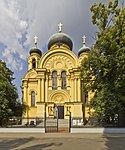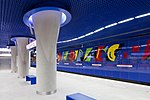St. Florian's Cathedral
1901 establishments in Poland20th-century Roman Catholic church buildings in PolandAC with 0 elementsBasilica churches in PolandBuildings and structures demolished in 1944 ... and 9 more
Buildings and structures in Poland destroyed during World War IIGothic Revival church buildings in PolandMinor basilicas in PolandPraga-PółnocRebuilt churches in PolandRoman Catholic cathedrals in PolandRoman Catholic churches completed in 1904Roman Catholic churches completed in 1972Roman Catholic churches in Warsaw

St. Florian's Cathedral, more formally known as the Cathedral of St. Michael the Archangel and St. Florian the Martyr (Polish: Katedra Świętego Michała Archanioła i Świętego Floriana), is a Roman Catholic church and minor basilica, dedicated to St. Florian. The church is located at 3 Floriańska Street in Praga-Północ district of Warsaw.
Excerpt from the Wikipedia article St. Florian's Cathedral (License: CC BY-SA 3.0, Authors, Images).St. Florian's Cathedral
Floriańska, Warsaw Praga-Północ (Warsaw)
Geographical coordinates (GPS) Address Phone number Website External links Nearby Places Show on map
Geographical coordinates (GPS)
| Latitude | Longitude |
|---|---|
| N 52.251666666667 ° | E 21.030833333333 ° |
Address
Katedra pw. Świętych Floriana i Michała Archanioła (Bazylika katedralna pw. Świętego Michała Archanioła i Świętego Floriana Męczennika)
Floriańska 3
03-707 Warsaw, Praga-Północ (Warsaw)
Masovian Voivodeship, Poland
Open on Google Maps











